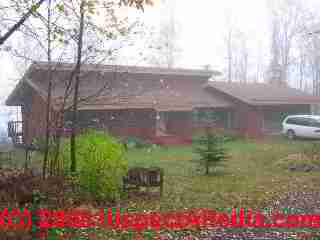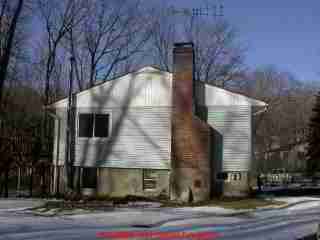 Septic Tank Location Video #1
Septic Tank Location Video #1
How to Walk the Site to Find the Septic Tank or Drainfield
- POST a QUESTION or COMMENT about how to find the septic tank for inspection, testing, or maintenance & repair.
How to find the septic tank:
A video guide to locating buried septic tanks in order to inspect, test, clean, or repair the septic system. How to locate the septic tank at a property, as step by step procedure to find any septic tank;
Where to look for the septic tanks, septic tank covers, or septic tank cleanout lids
InspectAPedia tolerates no conflicts of interest. We have no relationship with advertisers, products, or services discussed at this website.
- Daniel Friedman, Publisher/Editor/Author - See WHO ARE WE?
Video + Visual Outdoor Clues Can Tell The Septic Tank Location
Septic System Component Location Video #1 - how to find the septic tank?
Below: Video 1 of How to Find the Septic Tank & Drainfield: walk the site starting anywhere (we start in front of the home) to spot site features that are likely to rule-in or rule-out possible locations for a septic tank and then, in subsequent steps, the drainfield or leachfield or soakaway.
Click the image above, or use this YouTube URL https://youtu.be/eyQ4bDBJcLM to see the video above in a larger window.
Septic tank location guide
Here we provide detailed suggestions and procedures for finding a septic tank.
When the septic tank needs to be pumped, a regular maintenance task, the cost of that service will be less if the property owner found the septic tank location and perhaps even uncovered the septic tank pumping access cover.
Other reasons to find the septic tank include inspecting and testing septic systems when buying a home or for safety, to assure that the septic tank cover is in good condition.
The septic video shown here describes how we walk a homesite to find the septic tank and drainfield location.

Look for clues that often mark the location of a septic tank,
starting outside the area where the main waste line leaves the house. In this winter example, the depression near the house marks the septic tank cleanout which in this case was close to the surface.
Here is a closer look at snow melt indicating the tank location.
And here is a similar clue at melted depressions in snow cover which locate the septic LEACH FIELD LINES [photo] at the same property.
If you want to be really clever, click on this photo of the yard and end of the house to enlarge it and notice the window to the left of the chimney, and the round silver perforated "thing" to the left of and below that window? That's the plumbing waste line vent. We knew where the main waste line exited the house without needing to go inside to look!
The tank was likely to be in line with that vent which itself is likely to be just above the main waste line exit pipe.
Here are Visual Clues at that can Locate Septic System Components at a Homesite
- Stones, slates, stakes,
or other markers may have been left by a previous building owner to show the location of a septic tank pumpout access cover. - Pipes sticking up
out of the ground, perhaps between 10' and 20' from the home, especially if they are 4" to 6" diameter cast iron or white or black plastic, may mark vents or cleanouts on the waste line between the building and the septic tank, or they may mark the location of the tank itself.
Some septic pumping companies install a 6" top 8" "riser" pipe with a cap close to ground level (maybe painted green by the homeowner) which they use as a quick access port to pump the septic tank. It's easy to see if one of these ports is right over the tank, if one removes the pipe cap and peers inside, perhaps with a flashlight.
Watch out: SAFETY WARNING: do not walk over or near septic tanks where there are signs of impending collapse, such as soil subsidence. - Electrical boxes sticking up
out of the ground might mark the location of electrical connections feeding electrical components used in some septic systems.
Examples include septic tanks using effluent pumps to move effluent to an uphill location, pumping chambers using sewage grinder pumps to force sewage to an uphill septic tank and drainfield. A video showing a septic tank with a pumping station and its electrical connections is
at Septic 101 part 1: Video on How to find the septic system - Rectangular depressions
of perhaps 4 ft. x 8 ft. On the other hand, on rare occasions there may be a raised rectangular area if soils settled away from the septic tank. This happened at one of our properties because the bottom of the septic tank was sitting on bedrock and after backfill some soils around the tank settled and compacted but the tank didn't move a bit. - Rectangular areas of less grass growth -
if the tank is not buried very deep there is less soil over it - Areas of more lush grass growth - if the tank is leaking or backing up and spilling effluent around itself, the grass will be greener around the septic tank.
- Depressions in the soil
of perhaps 2 sq.ft. that may mark a previous excavation for tank pumping - Snow melt:
in climates where snow falls, areas of melted snow may mark the top of the septic tank (or areas of a failing leach field). A photo of this clue showing drainfield trenches as depressions in the snow can be seen
at VisualClues to Location - Drawings or sketches
of septic tank location are sometimes found in a building's basement or crawl space, sketched on a surface near the point where the main waste pipe exits the building. And of course a thoughtful owner may have left a drawing on paper somewhere for the new owners.
An example of a sketch locating septic system components is
at RECORDS to LOCATE the DRAINFIELD. - Wet areas
which may indicate a failing drainfield. Also septic odors. - Pipes ending in streams, lakes, or swamps,
or at the edge of a property sometimes mark an overflow drain that was added to cope with a failing septic system. A photo of one of these is
at UNLIKELY DRAINFIELD LOCATIONS - Thanks to Donica Ben
who points out the danger of digging into buried electrical wires (11/11/07) as we discuss further
at SEPTIC & CESSPOOL SAFETY PROCEDURES - CLOGGED DRAIN DIAGNOSIS - is the problem the septic system or the Building drain system?
- SEPTIC TANK SAFETY: Septic System, Septic Tank, & Cesspool Safety Warnings for Septic Inspectors, Septic Pumpers, and Homeowners
- SEPTIC TANK CONDITION - How to Inspect Septic Tanks and evaluate the septic tank condition, baffles, sludge levels, damage, evidence of septic failure
- SEPTIC DRAINFIELD SHAPE: septic drainfield or leaching bed shape and placement considerations
- SEPTIC DRAINFIELD LOCATION: how to find the septic drain field or leaching bed
- DRAINFIELD INSPECTION PROCEDURE Septic Leach Fields - how to inspect and diagnose septic drainfield failures
...
Continue reading at WHO KNOWS SEPTIC LOCATION? or select a topic from the closely-related articles below, or see the complete ARTICLE INDEX.
Or see these
Recommended Articles
- SEPTIC CLEARANCE DISTANCES
- SEPTIC DRAINFIELD LOCATION
- SEPTIC DRAINFIELD SIZE
- SEPTIC TANK COVERS
- SEPTIC TANK, HOW TO FIND
- DISTANCE TO SEPTIC TANK
- FIND MAIN WASTE LINE EXIT
- POSSIBLE SEPTIC TANK LOCATIONS
- SEPTIC TANK COVERS
- SEPTIC TANK DEPTH
- SEPTIC TANK DESIGN DEPTH
- SEPTIC TANK LOCATING EQUIPMENT
- SEPTIC TANK LOCATION SKETCH
- SEPTIC TANK RISERS
- SEPTIC TANK GRASS or SNOWMELT
- SEPTIC TROUBLE SIGNS, OTHER
- SOAKBED SOIL CONDITIONS
- SEPTIC LOCATION VIDEO
- VISUAL CLUES LOCATE the SEPTIC TANK
- WHO KNOWS SEPTIC LOCATION?
- SEPTIC TANK RISERS
- SEPTIC VIDEOS - home, showing how to find the septic system, septic tank, & septic drainfield
Suggested citation for this web page
VISUAL CLUES LOCATE the SEPTIC TANK at InspectApedia.com - online encyclopedia of building & environmental inspection, testing, diagnosis, repair, & problem prevention advice.
Or see this
INDEX to RELATED ARTICLES: ARTICLE INDEX to SEPTIC SYSTEMS
Or use the SEARCH BOX found below to Ask a Question or Search InspectApedia
Ask a Question or Search InspectApedia
Questions & answers or comments about how to find the septic tank for inspection, testing, or maintenance & repair..
Try the search box just below, or if you prefer, post a question or comment in the Comments box below and we will respond promptly.
Search the InspectApedia website
Note: appearance of your Comment below may be delayed: if your comment contains an image, photograph, web link, or text that looks to the software as if it might be a web link, your posting will appear after it has been approved by a moderator. Apologies for the delay.
Only one image can be added per comment but you can post as many comments, and therefore images, as you like.
You will not receive a notification when a response to your question has been posted.
Please bookmark this page to make it easy for you to check back for our response.
IF above you see "Comment Form is loading comments..." then COMMENT BOX - countable.ca / bawkbox.com IS NOT WORKING.
In any case you are welcome to send an email directly to us at InspectApedia.com at editor@inspectApedia.com
We'll reply to you directly. Please help us help you by noting, in your email, the URL of the InspectApedia page where you wanted to comment.
Citations & References
In addition to any citations in the article above, a full list is available on request.
- New York State Department of Health, APPENDIX 75-A WASTEWATER TREATMENT STANDARDS - INDIVIDUAL HOUSEHOLD SYSTEMS , [PDF] New York State Department of Health, 3 February 2010, retrieved 3/1/2010, original source: https://www.health.ny.gov/regulations/nycrr/title_10/part_75/appendix_75-a.htm
- Advanced Onsite Wastewater Systems Technologies, Anish R. Jantrania, Mark A. Gross. Anish Jantrania, Ph.D., P.E., M.B.A., is a Consulting Engineer, in Mechanicsville VA, 804-550-0389 (2006). Outstanding technical reference especially on alternative septic system design alternatives. Written for designers and engineers, this book is not at all easy going for homeowners but is a text I recommend for professionals--DF.
- Builder's Guide to Wells and Septic Systems, Woodson, R. Dodge: $ 24.95; MCGRAW HILL B; TP
- In addition to citations & references found in this article, see the research citations given at the end of the related articles found at our suggested
CONTINUE READING or RECOMMENDED ARTICLES.
- Carson, Dunlop & Associates Ltd., 120 Carlton Street Suite 407, Toronto ON M5A 4K2. Tel: (416) 964-9415 1-800-268-7070 Email: info@carsondunlop.com. Alan Carson is a past president of ASHI, the American Society of Home Inspectors.
Thanks to Alan Carson and Bob Dunlop, for permission for InspectAPedia to use text excerpts from The HOME REFERENCE BOOK - the Encyclopedia of Homes and to use illustrations from The ILLUSTRATED HOME .
Carson Dunlop Associates provides extensive home inspection education and report writing material. In gratitude we provide links to tsome Carson Dunlop Associates products and services.

